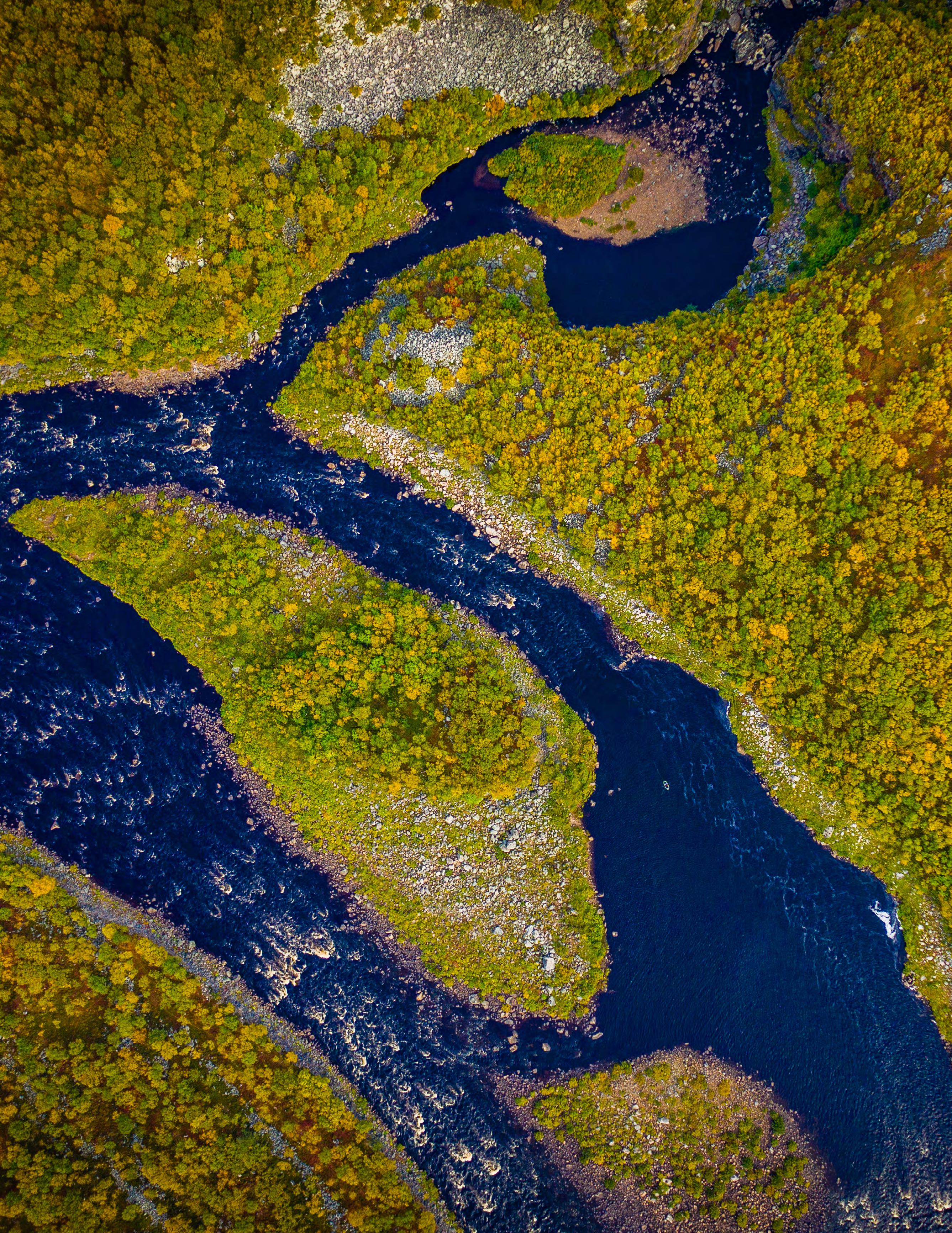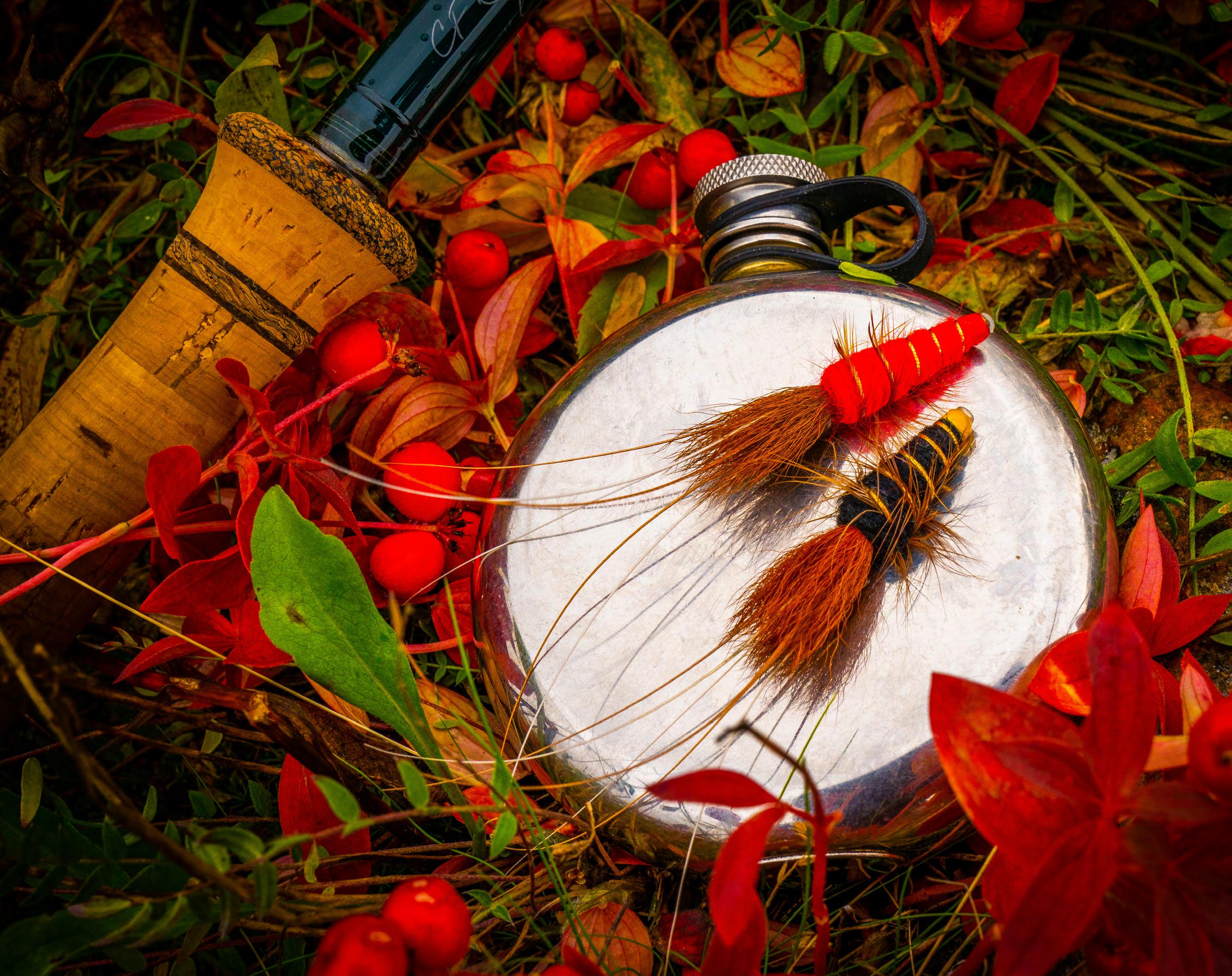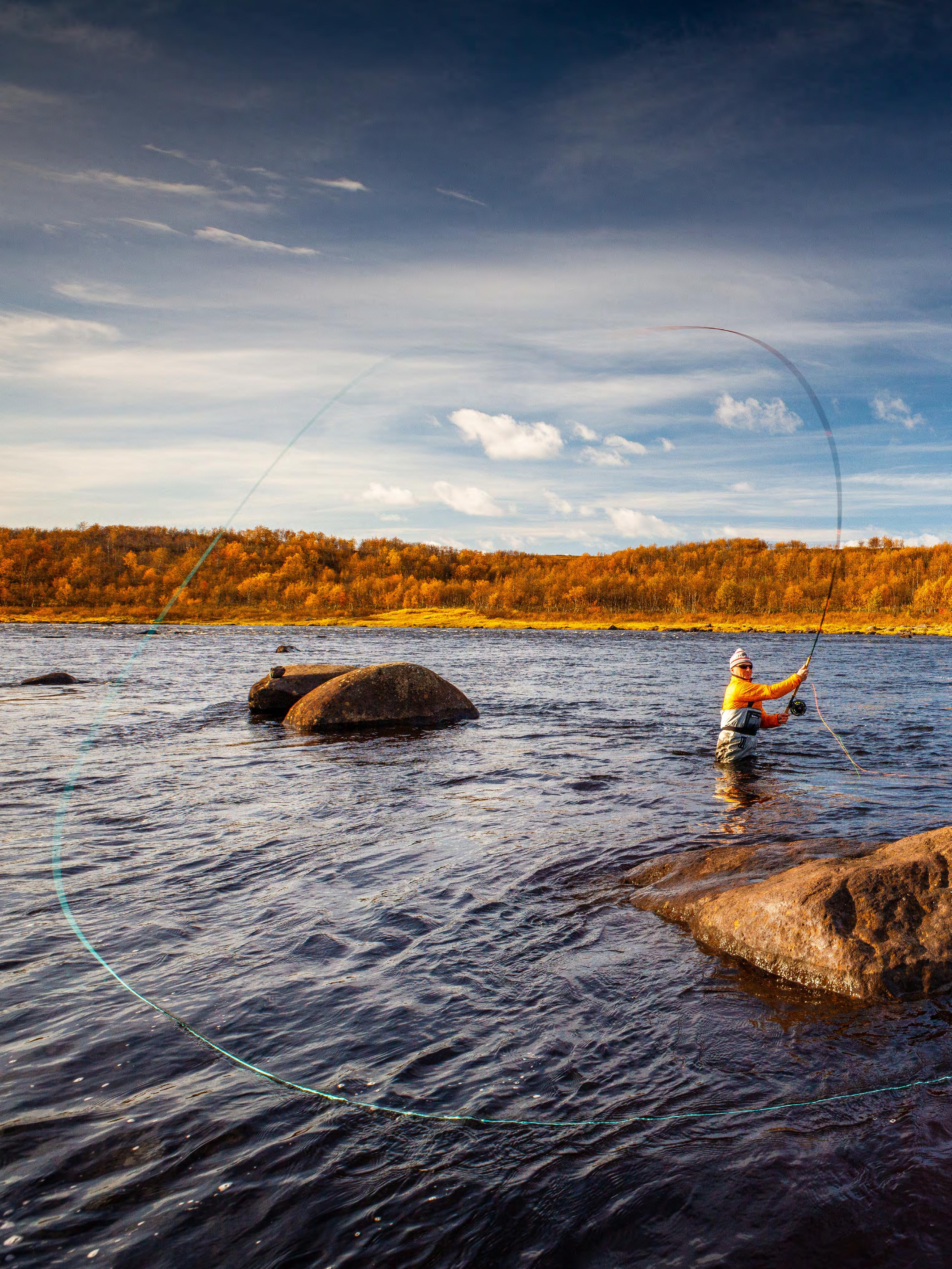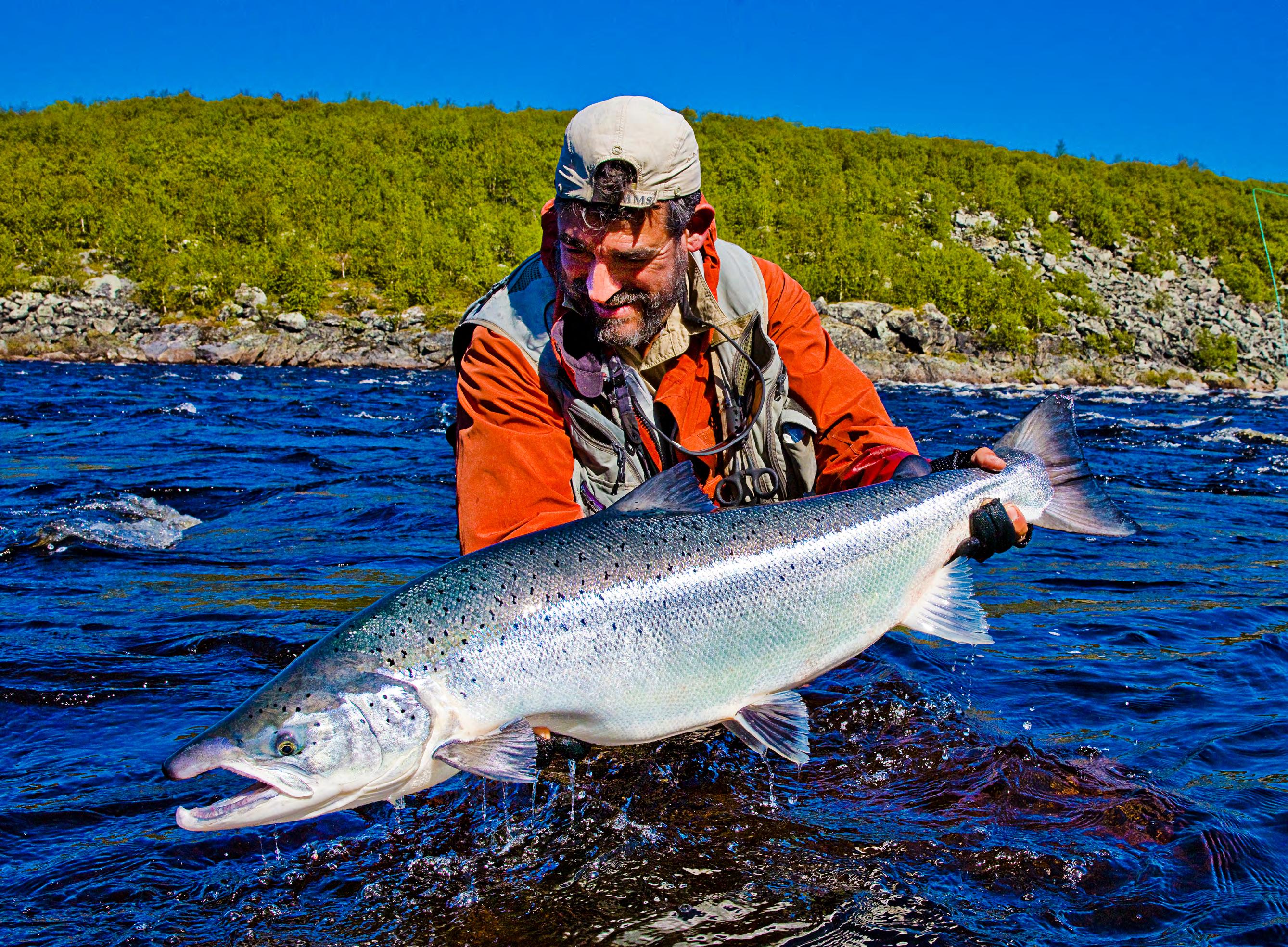
10 minute read
YOKANGA THE HEARTBREAKER
from Sportfishing Adventures - Issue 12 | Q4 2020
by Sportfishing Adventures - The world's best fishing destinations
Outside my window, a wild winter storm is raging. It’s late.
The house is sleeping, as I take another big slurp of Macallan and sit back to admire my handiwork. There in the vice, the last gleaming little “Bobby Clarkson” fly is finished, and is ready to join its brethren for a dab of varnish and a berth in the fly box. Six long months from now, that fly might just be swimming across the wide waters of the mighty Yokanga, my favourite river in all the world, high up in Russia’s arctic circle. I take another swig and wonder if perhaps it will be this same fly that will conjure a monster from the Yokanga’s icy, tannin-stained waters.
Advertisement
The storm is reaching a crescendo, and it inspires my imagination to go flying out through the night, up above the huddled-up, domesticated little towns and villages of England, out over the wild waves of the Atlantic to the perpetual bible-black night of the Arctic winter. Far out across the world in the frigid waters of the northern seas, the big silver monsters of the Yokanga are out there right now, gorging on the hapless baitfish as they pack on the muscle required to make that epic homeward voyage to the mighty river of their birth.

As I sit nursing the last of my whisky, I picture one, a vast fifty-pound behemoth, muscling its way through its lesser brethren as it prepares for its epic journey back to its birthplace on the Northern Kola Peninsula.

The Kola peninsula is one of the last places on earth where Atlantic salmon still thrive.
I imagine the perfect coincidence that will bring it nosing into Gremikha Bay as I playfully dig my old mates in the ribs and climb aboard that hulking great Mi-8 helicopter on the grey tarmac in Murmansk.
Perhaps lady luck will even choose to bring it barrelling upstream into the lie above the Lower Norcamp rapids for a breather, just as I send that same little fly now sitting in the jaws of my tying vice whistling out across the icy, early-season waters.
Perhaps...
I’ve been fortunate. I’ve fished far and wide, and cast a fly in over thirty countries. I love fishing for just about anything that swims, from the humble chub of my local River Cam in England to the piranhas of the Amazon Jungle, but the monsters of the Yokanga still haunt my dreams like no other fish that swims.

I’ve experienced some of the most exciting, and some of the most heart-breaking moments of my fly-fishing life on this special river. I’ve chased fish for over a mile on five separate occasions, and collapsed in an exhausted, broken heap after losing fish after 90 minutes of stumbling downstream and swimming across bays and feeder streams, only to see the running line snap or the hook pull free. These fish will break your heart like no other.

Two friends and a 37lb chrome beast!
In truth, Atlantic salmon are not a sensible choice as a chronic addiction right now – their numbers are being ruthlessly diminished by man’s refusal to respect and nurture their fragile habitat. An ugly cocktail of manmade factors, including salmon farming, indiscriminate and unregulated drift-netting, and countless environmental issues engendered by man’s insatiable desire for financial gain above all other considerations has led to a dramatic decline in their numbers.

The catastrophic sea-lice proliferation engendered by salmon farming in particular has had a devastating impact on salmon stocks all over Europe.
However, on the uttermost edge of the salmon’s range, on the far Northern coastline of Russia’s Kola Peninsula, Atlantic salmon are thriving. The rivers of the Northern Kola are celebrated by Atlantic salmon fishing aficionados as the last true sanctuary for trophy salmon. The rivers of the Kola are the last that can boast a genuine wilderness setting. The rivers are untouched by salmon farming or pollution, and their fish are as wild as the wind.

Many of the rivers are famed for their big fish, but one savage, uncut diamond stands out.
The Yokanga is a very special salmon river. The river’s salmon have been classified as the largest genetic strain on the Kola Peninsula by the Russian scientific organization PINRO (The Polar Research Institute). Every season, numerous fish of thirty pounds and more are caught. In 2019, in one week alone, 11 fish over 30 pounds were landed. The fish are not only spectacularly large. The Yokanga’s powerful currents, huge boulders, and numerous grade 5 rapids have forged a race of thick-set, broad shouldered salmon that are magnificently proportioned and in my opinion, uniquely strong.

Aerial view of the Yokanga.
While I have fly-fished far and wide in over thirty countries over the last two decades, I have fished the Yokanga every year since I first visited it in 2001.
It’s not just the monstrous size and power of the Yokanga fish that brings me back year on year. I love the wild, unfettered environment of the tundra, and I love the savage beauty of the river itself. This isn’t a classic salmon river, made up of long pools, to be mechanically covered by repetitive, cast and step fishing.
In this brawling brute of a river, the fish can be anywhere; in one of a million little glassy pockets hidden in one of the thunderous rapids that can easily be walked past in a rush to get to more obvious holding water.

The fly of choice for autumn on the Yokanga : a tungsten Frances.
This is salmon hunting
This isn’t fishing for the fair-weather angler. This is hard-core stuff. Look hard and whenever you see a possible holding spot, have the self-discipline to wade out and cover it.
If the current whisks your fly away too quickly, find a way to present it properly. Throw in an upstream mend, tie on a heavier fly…do whatever it takes and you may just be rewarded. A good presentation will often bring a brutish Yokanga trophy exploding out of your dreams and into your consciousness in a wild silver blur.
Work at it. Explore every pocket, wading out where necessary to target each and every lie with tenacity and discipline. Act on your hunches: switch flies and sink tips whenever your experience and intuition tells you to. Turn over your fly consistently, and don’t try to cast further than you are able to. Listen to your guide, but fish each and every spot that might just hold a fish.

What to pack
15’ 10 weight spey rods are the standard gun here, married up with a big, high capacity reel filled with at least 350 yards of well-maintained backing.
In the high, cold water of early season, the RIO Skagit Max Long in 700 grains will boss even the heaviest tips and flies, and a range of RIO’s Long MOW tips will get that big fly down and fishing fast in the small pockets that often produce a big fish.
Weighted tube flies like the German Snaelda are key to getting into the salmon’s eyeline before the river’s brutal currents whisk it away, and the Skagit features a big thick belly that is perfect for mending upstream to slow the fly’s progress in the cold water. A stout leader of 35 pound Seaguar fluorocarbon is the money, but it is not always sufficient to hold one of these runaway brutes from heading back to the sea. As the season progresses, it pays to switch to a more graceful presentation, and the RIO Scandi Body will throw smaller, lighter flies and slow-sinking tips with a stealth and delicacy not possible with the Skagit. That said, it pays to keep the Skagit to hand in case you want to throw a big heavy fly to a fish that refuses to commit to a smaller surface presentation.
When to go?
Yokanga can provide remarkable fish on any given day of the season, from the bitterly cold early season days of early June until the last days of the season in mid-September. While the prime weeks of the season at the end of June are the most prolific, I love the very early season weeks, when the brutal winter has yet to fully relinquish its icy grip on the Kola, and the fishing often involves battling through icy showers or stinging white blizzards. If you find the courage to brass it out on these brutal early-season days, your reward might well come in the form of a perfect chrome springer, flushed with a band of iridescent sapphire and peppered with long-tailed sea-lice.

Swinging flies with nature’s exploding colors as a background, in search of a matching color beast!
Those lice will betray that your prize was swimming in the Barents Sea while you were drinking your morning coffee in the lodge, just a few short hours ago.
As the river drops and clears into late June and July, the pools fill up with fish, and now is the time to tempt them with the magic of the riffle-hitch. Seeing one of these monsters crash through the surface to ingest a big sunray shadow pattern is simply unforgettable, and in the warmer water of early summer, the fish give of their best, often putting up a savage fight that can break both your 35 pound leader and your heart in one wretched instant.

The author with a fresh chrome bar.
Later, as the landscape becomes suffused with the intoxicating golden fire of early autumn, and the river bank becomes jewelled with scarlet cowberries, the big cock fish take on their spectacular prespawning livery. These leviathans now don their deep, rust-red coats, and their gill plates are crazed with delicate magenta and purple motifs.
An artfully presented black frances might just see one of these brutes burst up through the surface before cavorting off down the river like a circus clown. If you manage to subdue one of these late-season fish, the sight of one of these monstrous, kype-jawed brutes is one you will not soon forget. Whatever time of the season you choose, the Yokanga will almost certainly leave an indelible impression on your soul. You may well suffer the classic Yokanga heartbreak, replete with bruised knuckles and bent hooks. However, get lucky and occasionally everything goes right, and you get to lay your hands on a big Yokanga salmon.
Savour that moment
Releasing one of these magnificent brutes back into the icy arctic waters and watching it rocket upstream to complete its epic mission is elemental, life-affirming stuff. I cannot recommend it highly enough.

TRIP CONTACT
Matt Harris has fished all over the world, but he has returned to the Yokanga every year since he first fished it in 2001. Matt was recently asked to become General Manager by the new owner of Yokanga Lodges, the committed conservationist and passionate salmon angler Alexey Strulistov. If you’d like to discuss fishing the Yokanga, contact Matt at mattharris@yokanga.com


